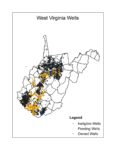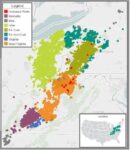This article originally provided by WBOY TV
Story by Pam Kasey
MORGANTOWN — A growing volume of brine from natural gas drilling and production is posing a challenge for municipal wastewater treatment plants.
The new waste stream can be a financial boon for plants that have spare capacity.
But at high volumes it can harm plant function — and water quality.
“We’re not removing the chlorides,” said Clarksburg wastewater plant Supervisor Bill Goodwin. “We just dilute it.”
In October, that dilution solution created problems in the Monongahela River in Pennsylvania.
The river exceeded standards for total dissolved solids: salts and other compounds that often result from the production of coal, coalbed methane and natural gas.
TDS is not a human health hazard. But at concentrations above Pennsylvania’s water quality standard of 500 milligrams per liter, it can impair the function of industrial equipment and affect the odor and taste of drinking water.
October laboratory tests quickly showed that the Monongahela River dissolved solids were high in chlorides, the signature of natural gas.
Nine municipal wastewater treatment plants in Pennsylvania received directives from the Pennsylvania Department of Environmental Protection to curtail the amount of gas well drilling brine they accept.
Two plants upriver in West Virginia accept brine as well: Weston and Clarksburg.
To be allowed to take brine from the gas industry, West Virginia municipal wastewater treatment facilities have to seek permit modifications, according to Yogesh Patel, assistant director of permitting at the West Virginia Department of Environmental Protection.
Weston and Clarksburg have carefully limited their brine influent from the beginning, Patel said.
But downstream, on the Ohio River, Wheeling found that it had to cut back on the volume of chlorides coming in brine.
Brine entering Weston’s treatment plant is a small part of the plant’s total volume, Patel said. It is written into a modified discharge permit and is not adversely affecting plant operation or discharges.
Clarksburg is in the third month of a trial period and, according Bill Goodwin, is experiencing no problems.
“We take 50,000 gallons a day, and that’s the maximum we can take for a plant this size,” Goodwin said. “The chlorides have to be 19,000 (mg/L), which is very low for the water that most of these guys are dealing with. They control the concentration by diluting it with weaker waters.”
The plant is having no trouble running the chlorides through the plant or meeting effluent standards, he said.
Wheeling, however, did have trouble.
The Wheeling plant has accepted wastewater from Washington, Pa.-based Liquid Assets Disposal pretreatment and trucking operation for about 15 years, according to Water Pollution Control Superintendent Albert King Campbell.
Around three years ago, LAD dramatically increased the amount of pretreated brine it delivered, Campbell said — from a few tanker loads a day to, now, “dozens upon dozens.”
That is, until November.
That’s because high chlorides in LAD’s waste stream interfered with Wheeling’s settling and ultraviolet disinfection.
DEP set daily and monthly limits on the volume of chlorides that could enter the plant — requiring LAD either to dilute, to pre-treat to a higher standard or, as has actually happened, to cut back on volume.
Wheeling’s modified permit sets limits for chlorides at its outfall: 1,238 mg/L average monthly and 2,484 mg/L maximum daily, limits Campbell said the plant is “just barely” meeting.
Campbell wasn’t sure yet after two weeks whether the reduction in chlorides was helping the plant’s function or not.
Revenues from LAD are a small part of Wheeling Water Pollution Control’s budget, according to Campbell.
But the money makes a big difference in Clarksburg.
“It’s a major revenue source for us,” Goodwin said. “It’s a good opportunity for all the municipalities in the state if we can get something that’s an environmentally safe way for them to dispose of it.”
Municipal treatment is an attractive option for some gas well drilling companies, whose alternatives include trucking the water greater distances for underground injection or arranging more expensive reverse osmosis treatment that can remove the chlorides.
However, since municipal treatment is really just dilution, the management of brine becomes, at high volumes, a watershed-level issue — one reflected in a federal law that prohibits states from issuing water pollution discharge permits that “cause or contribute to” water quality violations in downstream states.
To begin establishing a whole-watershed management strategy, Patrick Campbell of WVDEP was scheduled to meet Dec. 3 with Ron Schwartz in PADEP’s southwest regional office.
Campbell acknowledged that, with brine at its current volume and anticipated to rise as the gas industry pursues its interests in the Marcellus shale, the Ohio River and other regional rivers may not be able to assimilate everything the industry wants to discharge in the headwaters.
“We can only dilute this stuff for so long,” Campbell said at a Nov. 14 meeting on the topic in Morgantown. “It’s going to show up somewhere else.”
Related Links:
State Needs to Plan for Gas Well Drilling Brine
http://www.statejournal.com/story.cfm?func=viewstory&storyid=47274
Pa. Sewage Plants Ordered to Refuse Gas Well Drilling Water
http://www.statejournal.com/story.cfm?func=viewstory&storyid=46862










